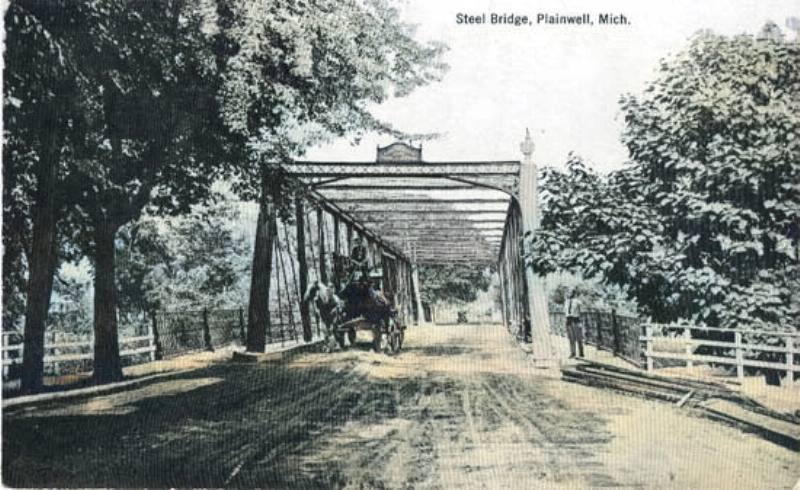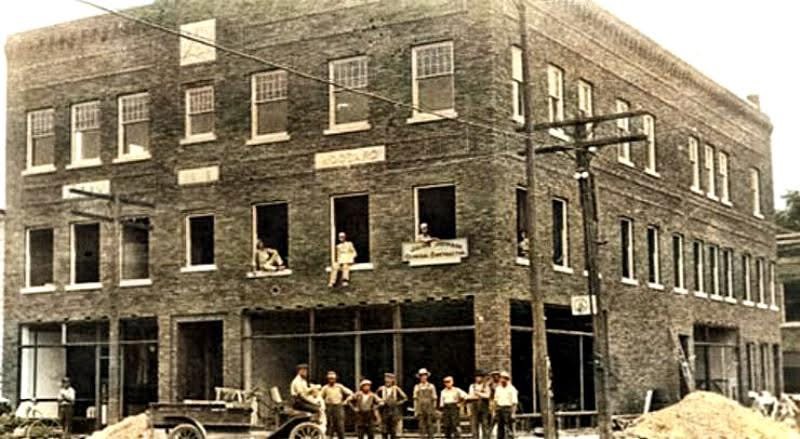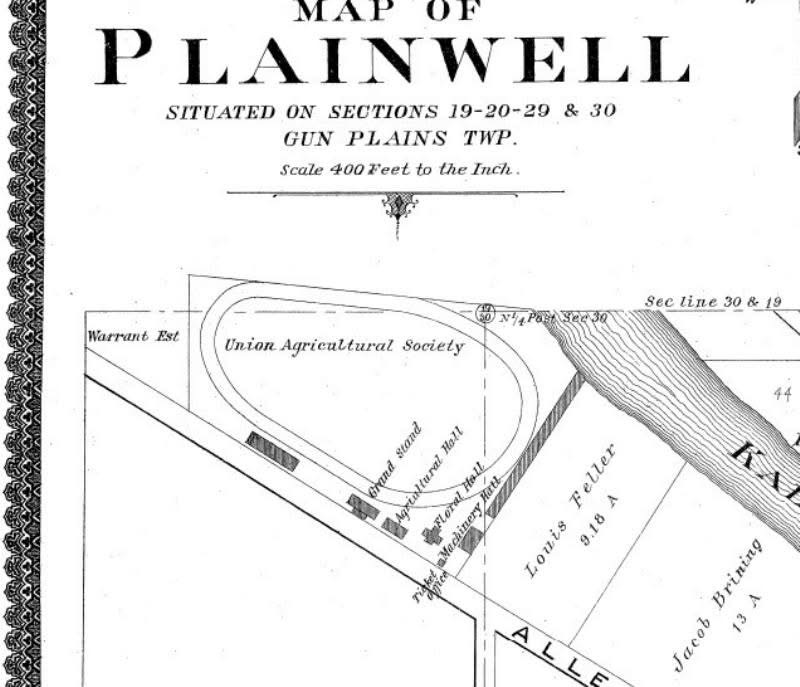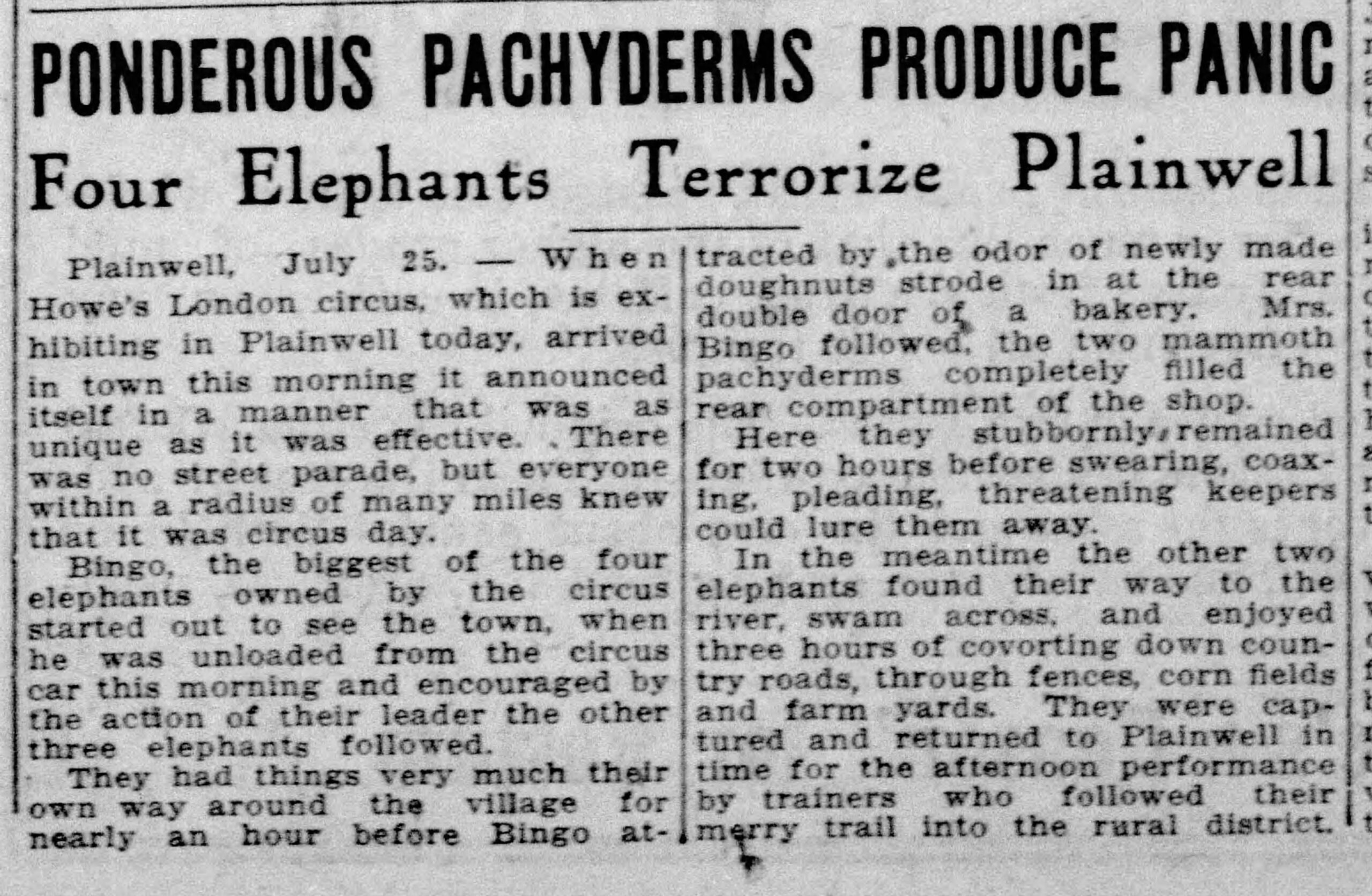When Circus Elephants Invaded Plainwell

It was a record-breaking July in 1916 when Howe’s Great London Circus rolled into Plainwell as part of its 45th annual tour. Newspapers noted a 10-day heat wave with temperatures many days soaring into triple digits.
Howe’s opened their season on April 4 in Montgomery Alabama and over the course of 35 weeks they traveled through 24 states (and countless cities) racking up 14,417 miles. The Michigan leg kicked off June 29 in Ironwood (on the Upper Peninsula border with Wisconsin) and after five days in the neighboring Great Lakes Sate, returned to the U.P. for two weeks. Crossing the Straits of Mackinac aboard one of the train car ferries, the circus landed in Cheboygan on the sunrise side then headed to Petoskey, Traverse City and Big Rapids before arriving in Plainwell—the last Michigan stop of the year—on Tuesday, July 25.
In 1916, Plainwell touted a population of 1,493 (a fraction of today’s 3,747). Over the years, other circus troupes had performed at the village’s fairgrounds on the west end of town, but this was the first and only visit by Howe’s…and it was a memorable one, to say the least!
A traditional day for Howe’s Great London Circus began early, as the entourage of people and exotic animals (as well as a plethora of tents, displays, exhibits, accessories and the like) traveled overnight between stops. Each show began with a morning parade from the train depot through town to the show site. Typically, there were two free performances a day—a matinee around 2 p.m. followed by an evening show at 8 p.m. Sometimes there was even a late-night “wild west” show beginning at 10 p.m.
Like most circuses of the time, Howe’s featured clowns, aerialists, acrobats, contortionists, comedians, bands and a menagerie of animals like camels, horses, lions and, of course, elephants. The average weight of an adult elephant generally ranges between 6,000 to 16,000 pounds (3-8 tons). Despite their size, elephants are often considered docile, intelligent and social creatures, although the fact that they’re prone to “never forget” can present challenges at times.
After unloading the elephants from the rail car on Plainwell’s east side, the handlers—likely under the direction of T.H. Newton, menagerie superintendent—made their way west along Bridge Street when they encountered the Iron Anderson Street Bridge spanning the Kalamazoo River. Known to sway, the bridge spooked the elephants, so circus crews decided to urge the large mammals to wade across the river instead (it is unclear whether they entered the water from north or south of Bridge Street). Regardless, the small herd soon split ways leaving the handlers scrambling to corral them.
Two of the elephants made their way north, likely passing the home of Amanda A. Ransom (which later became the Charles a. Ransom Free Public Library & Reading Room, dedicated on May 31, 1918, following her death the year prior) still standing on the northeastern banks of the river. Perhaps the land was cleared and construction was beginning on Riverside Creamery (now Dean’s Ice Cream) further up along the river’s edge. While the exact route is unknown, it was reported in the Kalamazoo Gazette that the pair spent three hours cavorting “down country roads, through fences, corn fields and farmyards” which have since been replaced by a handful of homes in neighborhoods just north of Plainwell’s downtown and the winding Kalamazoo River.
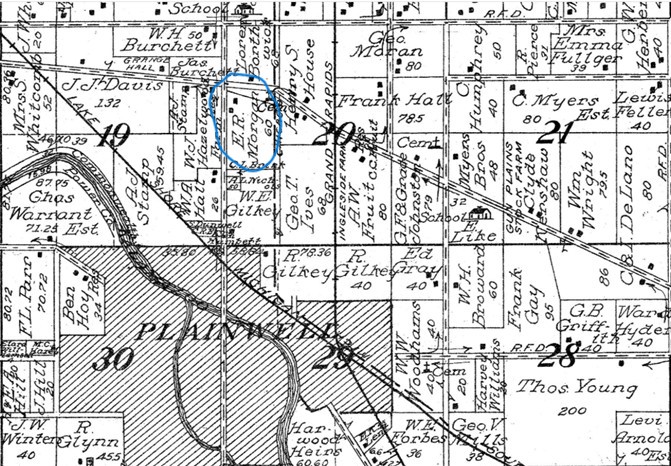
Widower Edwin R. Morgan owned a sizable tract of land on the east side of Dixie Highway (North Main Street) bordered by East 1st Street, Thomas Street and the Grand Rapids & Indiana Railroad, creating a trapezoidal lot. He was out raking hay that morning when he looked up to see at least one of the elephants in his field. Not to be shaken, he used his rake to guide the elephant downtown and back to its rightful owner.
Meanwhile, the largest of the elephants—Bingo—had been lured toward downtown by the aroma of fresh made doughnuts at Scribner’s Bakery, Confectionery and Ice Cream Parlor (108 S. Main Street today). The beastly creature lumbered into the alley not far from the small city jail and strode through the rear double doors of the bakery in search of sweet treats, followed closely by Mrs. Bingo. Imagine the surprise of the bakery staff as they encountered this pair of pachyderms! By this time, the circus team had arrived and they spent nearly two hours swearing, coaxing, pleading and threatening the elephants in attempts to move them along.
Well, Mr. & Mrs. Bingo finally did leave the bakery—but their shenanigans were far from over! The couple meandered next door where the Spencer-Woodard building was under construction. While the brick façade was standing tall (minus windows) there was only sub-floor in place. When Bingo navigated inside the building, his massive weight was more than the floor could hold and down he went, collapsing into the basement atop a debris field of wood. Now the circus leaders were faced with a gigantic conundrum…just HOW to get a 3-plus ton elephant out from its below-ground confinement.
The circus staff hemmed and hawed, scratched their heads and discussed how best to solve their very large problem. After much deliberation, they went searching for heavy railroad ties and used them to build a ramp up which Bingo could and did walk up and out to freedom and safety.
With all four elephants now accounted for, and the matinee time looming, the entourage swiftly made their way out to the fairgrounds and the show was soon underway. No reporting was made of the show’s highlights because it is certain that nothing could overshadow the performance of the elephants on patrol through Plainwell.
At the end of the day, the circus returned to the GR&I railyard on the east end of town, loaded up and headed to its next town in northern Indiana. Yet the elephant antics continued for the next two stops, at least.
The Niles Daily Sun ran a story later that week under the headline “Elephant is Heat Crazed” telling how not four but SEVEN elephants broke loose during the parade in Lagrange, Indiana, at 11:30 a.m. on Wednesday, July 26, wreaking havoc every step of the way.
Attributing the behavior to the 102-degree temperatures, the elephants damaged a half dozen buggies, knocked over hen houses, trampled gardens and smashed the porch of a photographer’s shop—the wife of the man so frantic she was left in a fragile state after the ordeal. Following a two-hour chase, “a posse of men armed with pitchforks and guns quickly gathered and succeeded in capturing five of the runaways,” the article stated. “Two animals were still at large somewhere between Lagrange [sic] and Shipshewana.
On July 30, The Fort Wayne Journal Gazette noted that the Howe elephants had stampeded in Ligonier the day before were the same animals that caused so much damage in Lagrange (and Plainwell, before that). The Angola Herald also reported about the elephant rampage in Ligonier on August 4 stating “the management assumed that the temper of the animals had improved and started them in the parade…when the animals bolted and started on a run through the streets, across lawns and gardens and down alleys [causing $100 in damage it was said].” The largest animal (Jumbo, per another article) high-tailed its way at full speed (20-25mph) to the New York Central tracks just as east-bound passenger train #2 neared. “Seeing the train the animal planted herself squarely on the track, ready to try conclusions with the oncoming train. The engineer, however, did not care for any such contests, and wisely brought his train to a stop before there was a collision.”
For photographs of the elephants of Howe’s Great London Circus from 1913 (pg. 7, 9): https://digital.library.illinoisstate.edu/digital/collection/p15990coll5/id/7962/
Newspaper articles sourced from Newspapers.com. Images sourced from the “You Know You’re From Plainwell If You Remember…” Facebook group.

